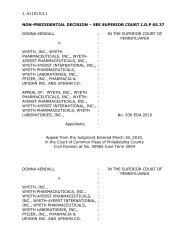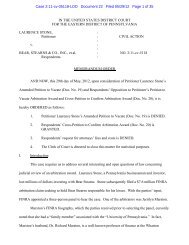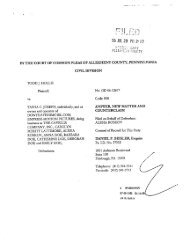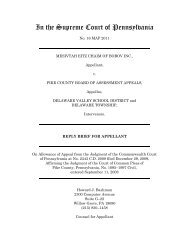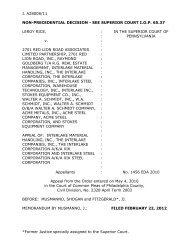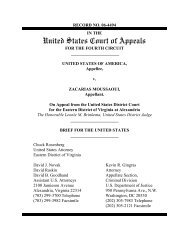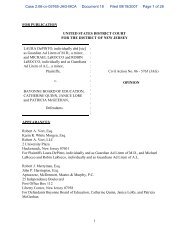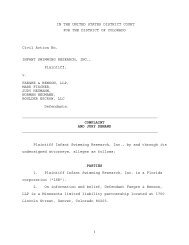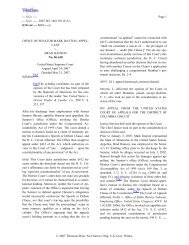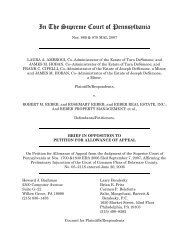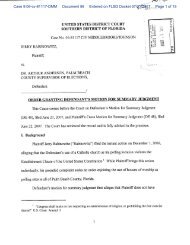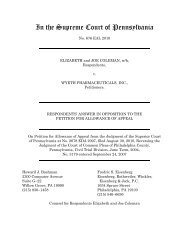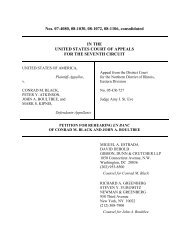reply brief - How Appealing
reply brief - How Appealing
reply brief - How Appealing
You also want an ePaper? Increase the reach of your titles
YUMPU automatically turns print PDFs into web optimized ePapers that Google loves.
In the Superior Court of Pennsylvania<br />
No. 2905 EDA 2008<br />
PATSY LANCE, Administratrix for the Estate of<br />
CATHERINE RUTH LANCE, Deceased,<br />
Appellant,<br />
v.<br />
WYETH, f/k/a<br />
AMERICAN HOME PRODUCTS CORP.<br />
REPLY BRIEF FOR APPELLANT<br />
On Appeal from the Judgment of the<br />
Court of Common Pleas of Philadelphia County, Pennsylvania,<br />
Civil Trial Division, November Term 2006, No. 926<br />
<strong>How</strong>ard J. Bashman<br />
2300 Computer Avenue<br />
Suite G–22<br />
Willow Grove, PA 19090<br />
(215) 830–1458<br />
Counsel for Plaintiff/Appellant<br />
Linda C. Love<br />
Michael L. Williams<br />
Williams Love O’Leary & Powers, P.C.<br />
9755 S.W. Barnes Road<br />
Suite 450<br />
Portland, OR 97225–6681<br />
(503) 946–5412
TABLE OF CONTENTS<br />
Page<br />
I. ARGUMENT IN REPLY .................................................................................... 1<br />
A. The Trial Court Erred In Entering Summary Judgment In<br />
Favor Of Wyeth On Plaintiff’s Claims For Negligently<br />
Marketing Redux And Negligently Failing To Withdraw Redux<br />
From The Market ..................................................................................... 1<br />
1. Plaintiff’s claims against Wyeth for negligently marketing<br />
Redux and negligently failing to withdraw Redux from<br />
the market are cognizable under Pennsylvania law .................... 1<br />
II. CONCLUSION .................................................................................................... 7
Cases<br />
TABLE OF AUTHORITIES<br />
– ii –<br />
Page<br />
Bichler v. Eli Lilly & Co., 436 N.E.2d 182 (N.Y. 1982) ................................................ 3<br />
Brochu v. Ortho Pharmaceutical Corp., 642 F.2d 652 (1st Cir. 1981) ......................... 2<br />
Harris v. Toys “R” Us–Penn, Inc., 880 A.2d 1270 (Pa. Super. Ct. 2005) ..................... 4<br />
In re Diet Drugs, 2000 WL 1222042 (E.D. Pa. 2000) ................................................ 1, 3<br />
Smith v. Wyeth–Ayerst Laboratories Co.,<br />
278 F. Supp. 2d 684 (W.D.N.C. 2003)............................................................. 4, 6<br />
Court Rules<br />
Pa. R. App. P. 302(a) ...................................................................................................... 4
I. ARGUMENT IN REPLY<br />
A. The Trial Court Erred In Entering Summary Judgment In<br />
Favor Of Wyeth On Plaintiff’s Claims For Negligently<br />
Marketing Redux And Negligently Failing To Withdraw Redux<br />
From The Market<br />
1. Plaintiff’s claims against Wyeth for negligently<br />
marketing Redux and negligently failing to withdraw<br />
Redux from the market are cognizable under<br />
Pennsylvania law<br />
According to Wyeth’s Brief for Appellees, to the extent that Pennsylvania law<br />
appears to recognize claims against a prescription drug manufacturer alleging<br />
negligent marketing and negligent failure to withdraw from the market, negligent<br />
failure to test, and negligent design defect, those types of claims can all be re–<br />
characterized as negligent failure to warn claims. If Wyeth is correct, then Wyeth<br />
has conceded that the precise claims that plaintiff seeks to assert against Wyeth in<br />
this lawsuit are claims recognized as valid under Pennsylvania law. Thus, under<br />
even Wyeth’s view of this case, the trial court’s entry of summary judgment against<br />
plaintiff should be reversed.<br />
As plaintiff explained in her opening <strong>brief</strong>, what differentiates this case from<br />
an ordinary negligent failure to warn case against a prescription drug manufacturer<br />
is that this case involves a product that Wyeth should never have permitted to be<br />
sold to any class of patients, as demonstrated by the FDA’s decision completely<br />
banning these drugs from the market. See In re Diet Drugs, 2000 WL 1222042, at *2<br />
(E.D. Pa. 2000) (noting that “[o]n September 15, 1997, AHP and the FDA announced<br />
that there would be no further sales of Pondimin and Redux in the United States”).
In other words, it was the FDA’s ultimate determination that no warning could<br />
suffice to make these drugs safe and effective as to any potential class of patients.<br />
And here it is plaintiff’s contention that either Wyeth should never have brought<br />
this drug to market or, at a minimum, should have realized that the drug did not<br />
deserve to remain on the market before the drug was prescribed to plaintiff’s<br />
decedant.<br />
To be sure, Wyeth could still try to transform even this sort of a case into a<br />
“failure to warn” action, because if Wyeth had warned physicians “do not use this<br />
medication for any reason because this medication’s risks outweigh its benefits as to<br />
all potential classes of patients,” presumably no doctors would have prescribed the<br />
medication. But, as both common sense and the facts of this case illustrate, once a<br />
drug is determined to be too unsafe to be prescribed to any potential class of users,<br />
the manufacturer’s duty is not merely to warn against any usage whatsoever but<br />
also to withdraw the medication from the market. Had that happened here, the<br />
plaintiff’s daughter would not have sustained PPH as a result of taking Redux and<br />
would not have died from that Redux–induced illness.<br />
As the U.S. Court of Appeals for the First Circuit has recognized, where a<br />
“proper warning would result in the nonmarketability of [the] product, then the true<br />
issue is [the] acceptability of [the product’s] basic design.” See Brochu v. Ortho<br />
Pharmaceutical Corp., 642 F.2d 652, 657 n.6 (1st Cir. 1981). In other words, where<br />
no warning can make a product safe, which even the FDA agrees is the case with<br />
Redux, then a person injured by the product is not limited to bringing a failure to<br />
– 2 –
warn claim. Similarly, the Court of Appeals of New York — that State’s highest<br />
Court — has recognized that pharmaceutical manufacturers can face liability for<br />
injuries caused by their dangerous medications under either a “duty to warn theory”<br />
or a “failure to test theory.” See Bichler v. Eli Lilly & Co., 436 N.E.2d 182, 190 (N.Y.<br />
1982). This Court should likewise rule that Pennsylvania law would not limit the<br />
plaintiff to a negligent failure to warn claim under the circumstances presented<br />
here.<br />
Wyeth asserts that Pennsylvania courts have expressed a reluctance to<br />
second–guess the FDA concerning the relative worth of a prescription drug or<br />
whether a given drug deserves to be available on the market. Regardless of<br />
whether, and if so to what extent, that is accurate, Wyeth’s argument overlooks that<br />
here the FDA has long ago decided that Redux is unsafe for any potential class of<br />
patients and that the drug, therefore, cannot be offered for sale to anyone. See In re<br />
Diet Drugs, 2000 WL 1222042, at *2. Plaintiff is not asking this Court to second–<br />
guess the FDA’s ultimate, fully–informed decision about the relative usefulness of<br />
Redux; rather, plaintiff is merely contending that Wyeth itself should have reached<br />
that same conclusion earlier instead of ignoring and attempting to hide the data<br />
that ultimately compelled such a conclusion.<br />
Wyeth additionally contends that because it was the valvular heart disease<br />
(VHD) risk of Redux that caused Wyeth to ultimately remove the drug from the<br />
market and the FDA to prohibit the drug’s continued availability for any purpose<br />
whatsoever, plaintiff cannot establish proximate cause since her daughter’s death<br />
– 3 –
was due to PPH rather than VHD. Unlike in the Cochran and Owens cases, in this<br />
case Wyeth did not advance this proximate cause argument in the trial court<br />
(except for a cursory footnote in its trial court <strong>reply</strong> <strong>brief</strong>, see R.517a), nor did the<br />
trial court rely on that ground in granting summary judgment, and therefore this<br />
Court should treat this argument as waived on appeal. See Pa. R. App. P. 302(a)<br />
(“Issues not raised in the lower court are waived and cannot be raised for the first<br />
time on appeal”); Harris v. Toys “R” Us–Penn, Inc., 880 A.2d 1270, 1279 (Pa. Super.<br />
Ct. 2005) (“We have repeatedly held that failure to develop an argument with<br />
citation to, and analysis of, relevant authority waives that issue on review.”).<br />
Nevertheless, because Wyeth has now raised in this case the issue of the<br />
relevance of VHD warnings where the plaintiff’s injuries were caused by PPH, we<br />
wish to draw to this Court’s attention a Charlotte, North Carolina–based federal<br />
district court’s decision from 2003 in a case involving the “Fen–phen” medication<br />
Pondimin in which the court ruled that the plaintiff could rely on the medication’s<br />
inadequate VHD warnings in plaintiff’s failure to warn lawsuit notwithstanding<br />
that the plaintiff’s injury consisted of PPH. See Smith v. Wyeth–Ayerst Laboratories<br />
Co., 278 F. Supp. 2d 684, 705–707 (W.D.N.C. 2003).<br />
The federal district court’s ruling in Smith deserves to be quoted at length,<br />
given that it is directly on point:<br />
Defendant’s final motion requests that the Court exclude all<br />
evidence regarding side effects of Pondimin other than PPH, namely,<br />
valvular heart disease or “VHD.” In support, Defendant notes that<br />
Plaintiff does not have VHD, and doesn’t allege so in her Complaint.<br />
Moreover, prior to initiation of this lawsuit, Plaintiff settled any claims<br />
she had against Defendant in a class action suit with the exception of<br />
– 4 –
injuries related to PPH. Plaintiff opposes Defendant’s motion,<br />
contending that evidence of VHD is directly relevant for purposes of<br />
her failure to warn claim and inadequate drug label claim. According<br />
to Plaintiff, evidence related to the VHD cases demonstrate<br />
Defendant’s knowledge of risks associated with the use of<br />
fenfluramines, the risk/benefit analysis, and proximate cause or cause–<br />
in–fact. Additionally, Plaintiff points out that the VHD occurrences are<br />
what led to the withdrawal of fenfluramines from the market at the<br />
FDA’s request and that it is an integral part of the background of this<br />
case.<br />
* * *<br />
Evidence regarding instances of VHD associated with<br />
fenfluramines as used to treat obesity is, in fact, relevant to<br />
demonstrate the knowledge of Defendant. Under North Carolina law, a<br />
products liability action based upon negligence requires the plaintiff to<br />
prove the following essential elements: 1) duty; 2) breach; 3) causation;<br />
and 4) damages. Bryant v. Adams, 116 N.C. App. 448, 465, 448 S.E.2d<br />
832 (1994). A duty to warn arises when the supplier of a product knows<br />
or has reason to know that the product is, or can be, dangerous for the<br />
use for which it is supplied. Stegall v. Catawba Oil Co., 260 N.C. 459,<br />
133 S.E.2d 138 (1963). In order to prove causation, a products liability<br />
plaintiff asserting a failure to warn claim must show that the injury<br />
was caused by the defendant’s failure to warn. N.C. Gen. Stat. §99B–5.<br />
Defendant’s knowledge, or lack thereof, regarding the potential<br />
dangers of its product are indeed relevant to the issues of duty and<br />
causation.<br />
When considering a negligence claim based upon failure to<br />
warn, and specifically the element of causation, it is the decision<br />
process of Plaintiff, as opposed to the specific injury, that must be<br />
considered. * * *<br />
In this case, Plaintiff alleges that had she known of the risk of<br />
VHD associated with fenfluramine use, she would never have<br />
requested a prescription, or taken fen–phen. Similarly, Plaintiff<br />
presents an affidavit from Dr. Fisher, who was first to prescribe fenphen<br />
for Plaintiff’s obesity, in which Dr. Fisher avers that he would not<br />
have prescribed fen–phen had he been aware of the risks of VHD.<br />
(Fisher Affidavit, 6) Moreover, Plaintiff does not allege that she<br />
suffers from VHD and the jury can be instructed on this at the outset<br />
of the trial. Further, when this evidence is presented, Defendant’s<br />
concerns regarding confusion of the issues can be addressed with a<br />
– 5 –
special cautionary instruction. In light of its probative value on the<br />
issue of notice to Defendant, duty to warn, and causation, the<br />
probative value of VHD evidence is not substantially outweighed by<br />
the risk of unfair prejudice to Defendant.<br />
Smith, 278 F. Supp. 2d at 706–07.<br />
Unlike any of the cases that Wyeth has cited in its Briefs for Appellees in the<br />
Cochran, Owens, or Lance cases, the North Carolina federal district court’s ruling in<br />
Smith is a decision that is directly on point. The federal district court in Smith<br />
rejected the very arguments that Wyeth is asking this Court to accept — that<br />
evidence of VHD is not relevant to a prescription drug failure to warn lawsuit in<br />
which the plaintiff suffers from PPH as a result of having consumed Wyeth’s now–<br />
discontinued “Fen–phen” medications. This Court should reject Wyeth’s arguments,<br />
as did the North Carolina federal district court in its persuasive ruling in the Smith<br />
case.<br />
– 6 –
II. CONCLUSION<br />
For the reasons set forth above and in our opening Brief for Appellant, this<br />
Court should reverse the trial court’s entry of summary judgment in Wyeth’s favor<br />
and should remand this case for trial.<br />
Dated: May 10, 2010<br />
– 7 –<br />
Respectfully submitted,<br />
Linda C. Love<br />
Michael L. Williams<br />
Williams Love O’Leary & Powers, P.C.<br />
9755 S.W. Barnes Road<br />
Suite 450<br />
Portland, OR 97225–6681<br />
(503) 946–5412<br />
<strong>How</strong>ard J. Bashman<br />
2300 Computer Avenue<br />
Suite G–22<br />
Willow Grove, PA 19090<br />
(215) 830–1458<br />
Counsel for Plaintiff/Appellant
CERTIFICATE OF SERVICE<br />
I hereby certify that I am this day serving two true and correct copies of the<br />
foregoing document upon the persons and in the manner indicated below which<br />
service satisfies the requirements of Pa. R. App. P. 121:<br />
Dated: May 10, 2010<br />
Service by First Class U.S. Mail addressed as follows:<br />
Michael T. Scott, Esquire<br />
Henry F. Reichner, Esquire<br />
Barbara R. Binis, Esquire<br />
Ira S. Lefton, Esquire<br />
Reed Smith, L.L.P.<br />
2500 One Liberty Place<br />
Philadelphia, PA 19103<br />
(215) 851–8100<br />
Counsel for Wyeth<br />
Raymond M. Williams, Esquire<br />
DLA Piper LLP (US)<br />
One Liberty Place<br />
1650 Market Street – Suite 4900<br />
Philadelphia, PA 19103<br />
(215) 656–3368<br />
Counsel for Wyeth<br />
Tobias L. Millrood, Esquire<br />
Pogust, Braslow & Millrood, L.L.C.<br />
161 Washington Street<br />
Suite 1520<br />
Conshohocken, PA 19428<br />
(610) 941–4204<br />
Co–counsel for Appellant<br />
<strong>How</strong>ard J. Bashman<br />
2300 Computer Avenue<br />
Suite G–22<br />
Willow Grove, PA 19090<br />
(215) 830–1458



